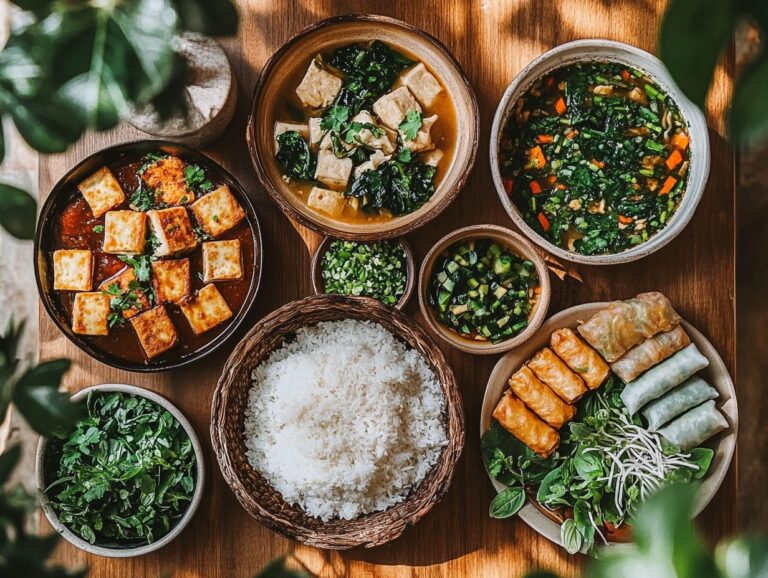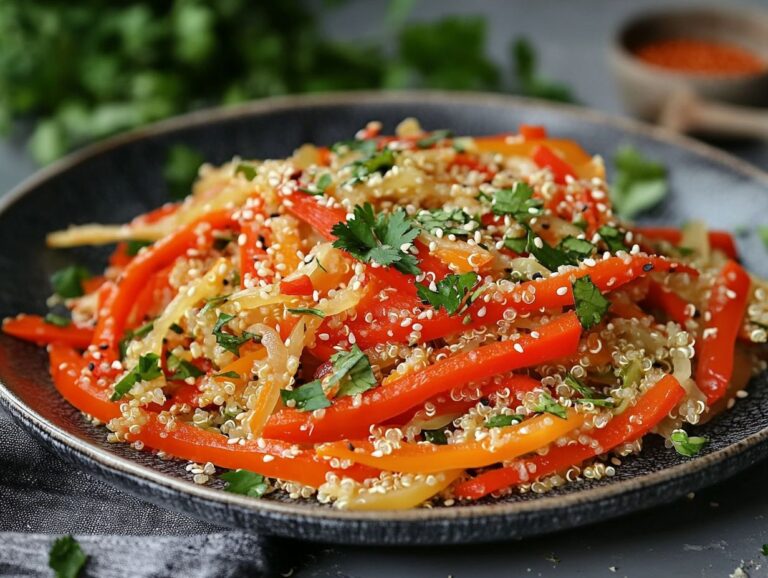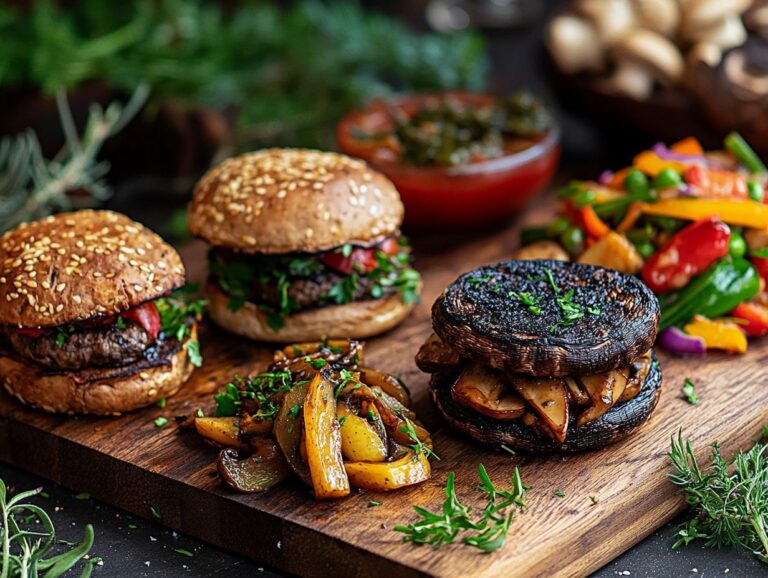Rosh Hashanah, the Jewish New Year, is a time for reflection, renewal, and joyful feasting with loved ones. This year, consider embracing a plant-based approach that honors tradition while promoting health and sustainability. Delve into the symbolic significance of Rosh Hashanah, explore the numerous benefits of a vegan diet, and discover a variety of mouthwatering vegan recipes that include sweet and savory options. From appetizers to desserts, learn how to celebrate the holiday with delicious, eco-friendly dishes and festive cuisine that everyone will enjoy.
The Significance of Rosh Hashanah
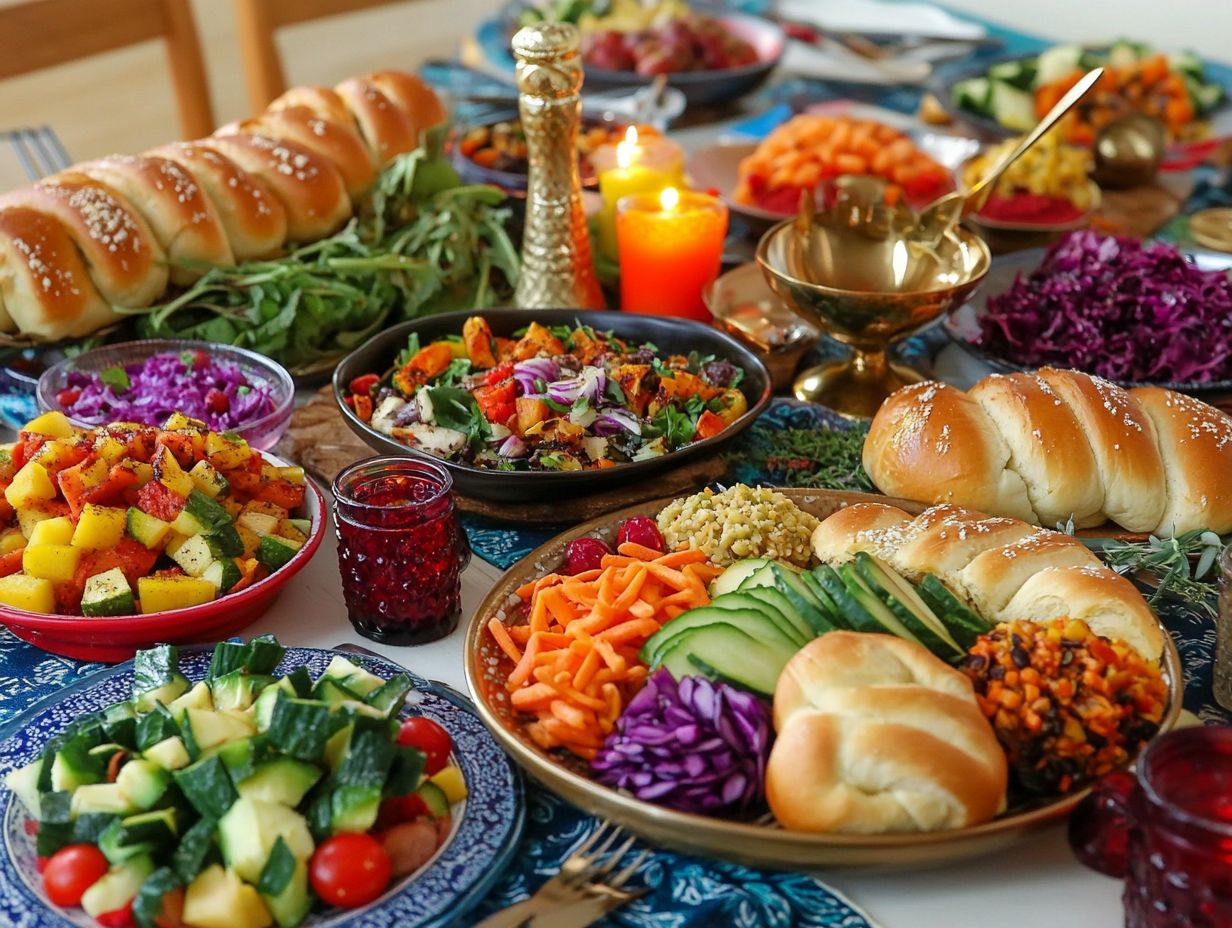
Rosh Hashanah, known as the Jewish New Year, holds significant cultural importance within the Jewish community and is rich with traditional Jewish food. This holiday is celebrated with a variety of foods, both traditional and newly adopted, including symbolic foods like apple and honey.
Festive meals bring family members together, emphasizing Rosh Hashanah as a time of renewal and reflection, while fostering a strong sense of community. The importance of family is highlighted during these meals, where traditional foods such as challah and matzo ball soup play a vital role. Symbolic dishes, particularly sweet foods like apples and honey, represent hope and prosperity, enhancing seasonal celebrations. Apples are associated with the wish for a sweet new year, while honey symbolizes the hope for a joyful and abundant life.
Beyond family gatherings, community celebrations serve as reminders of friendship, connection, and the collective practice of the Jewish faith, while enjoying cultural dishes. In many households, meal preparation becomes a special ritual, with the diverse array of dishes reflecting the varied cultural backgrounds of Jewish communities worldwide.
Family members come together to recite prayers and share stories from the past, creating an atmosphere rich with reflection, anticipation, and cultural dishes.
The Benefits of a Vegan Diet
The benefits of a vegan diet encompass healthy cooking, ethical eating, environmental care, and the potential to reduce the risk of chronic diseases. A plant-based diet promotes healthy eating and ethical consumption while also fostering environmental sustainability.
It achieves this by replacing diets high in animal products with those rich in fresh fruits, vegetables, whole grains, and other nutrient-dense food options. By adopting plant-based proteins and eliminating animal products, individuals align with ethical eating principles, which advocate for a compassionate approach to food production, distribution, and consumption—essential components of any sustainable dietary practice and healthy cooking.
Additionally, veganism can enhance creativity in the kitchen by introducing a myriad of flavors and cuisines that individuals may not have previously explored. This includes experimenting with new recipes that substitute dairy and meat products, as well as preparing dishes that highlight colorful seasonal ingredients and vegetables.
Engaging with the vegan community allows individuals to share ideas, discover new techniques, and explore innovative flavor profiles, fostering culinary creativity and plant-forward dishes.
Furthermore, the pursuit of ethical eating and environmental care often encourages community involvement and community bonds. Many individuals find local vegan organizations, potlucks, and farm-to-table initiatives, allowing them to connect with others and build a strong sense of community.
Vegan Appetizers for Rosh Hashanah
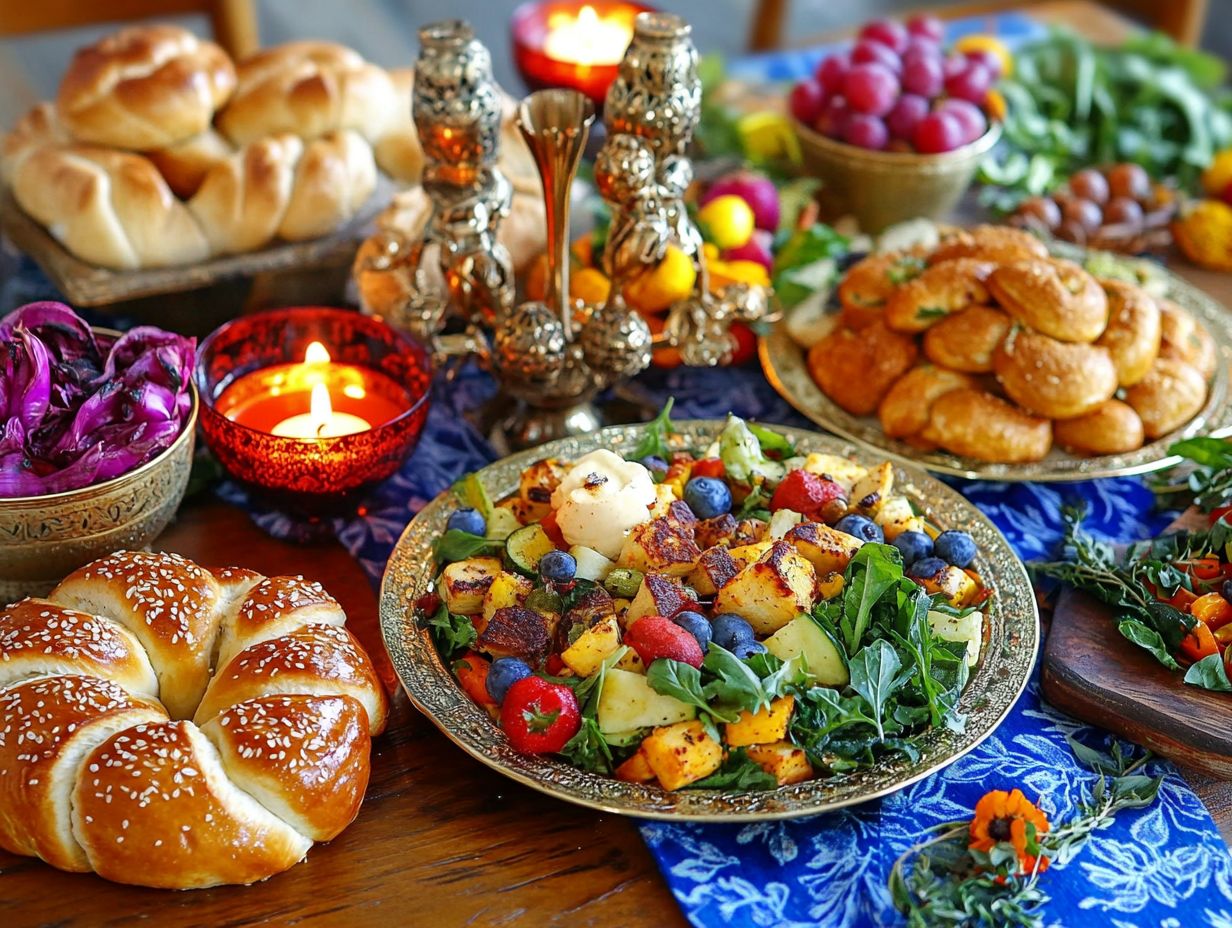
Holiday appetizers for Rosh Hashanah offer a wonderful opportunity to enhance the traditional meal while showcasing the creative culinary possibilities of plant-based dishes that celebrate Jewish culture.
Options such as vibrant pomegranate salad and savory pies filled with seasonal vegetables and nutritious meals provide delicious alternatives that honor cultural heritage while accommodating a variety of dietary preferences.
Incorporating fresh herbs and aromatic spices elevates the flavor profiles, ensuring that each bite is a delightful addition to family gatherings and festive celebrations, and aligns with the tradition of festive gatherings.
Traditional Dishes with a Vegan Twist
Veganizing traditional Rosh Hashanah foods allows us to maintain culinary traditions while accommodating modern dietary needs. Recipes for classic dishes like matzo ball soup and challah bread can be adapted into vegan and dairy-free versions by using lentils or chickpeas as substitutes for eggs, ensuring that these comforting foods can still be enjoyed during holiday meals.
By infusing traditional Rosh Hashanah dishes with a vegan twist, we preserve cherished culinary traditions while embracing contemporary dietary preferences.
Reimagining classic recipes enables the creation of plant-based versions that retain their original flavors while catering to vegan and dairy-free diets.
For example, matzo ball soup can be reinvented by using aquafaba in place of eggs, yielding fluffy dumplings that float delicately in a rich vegetable broth, exemplifying healthy alternatives. Similarly, vegan challah can be customized by substituting honey with maple syrup or agave nectar, providing a delightful sweetness while remaining fully vegan.
Another dish that benefits from this culinary creativity is gefilte fish, which can be made using a blend of mashed fava beans and herbs, honoring the original flavors while offering a wholesome alternative, an example of innovative cooking.
These adaptations not only preserve the essence of tradition but also invite everyone to enjoy satisfying meals and crowd-pleasers that align with contemporary values.
Main Course Vegan Recipes for Rosh Hashanah
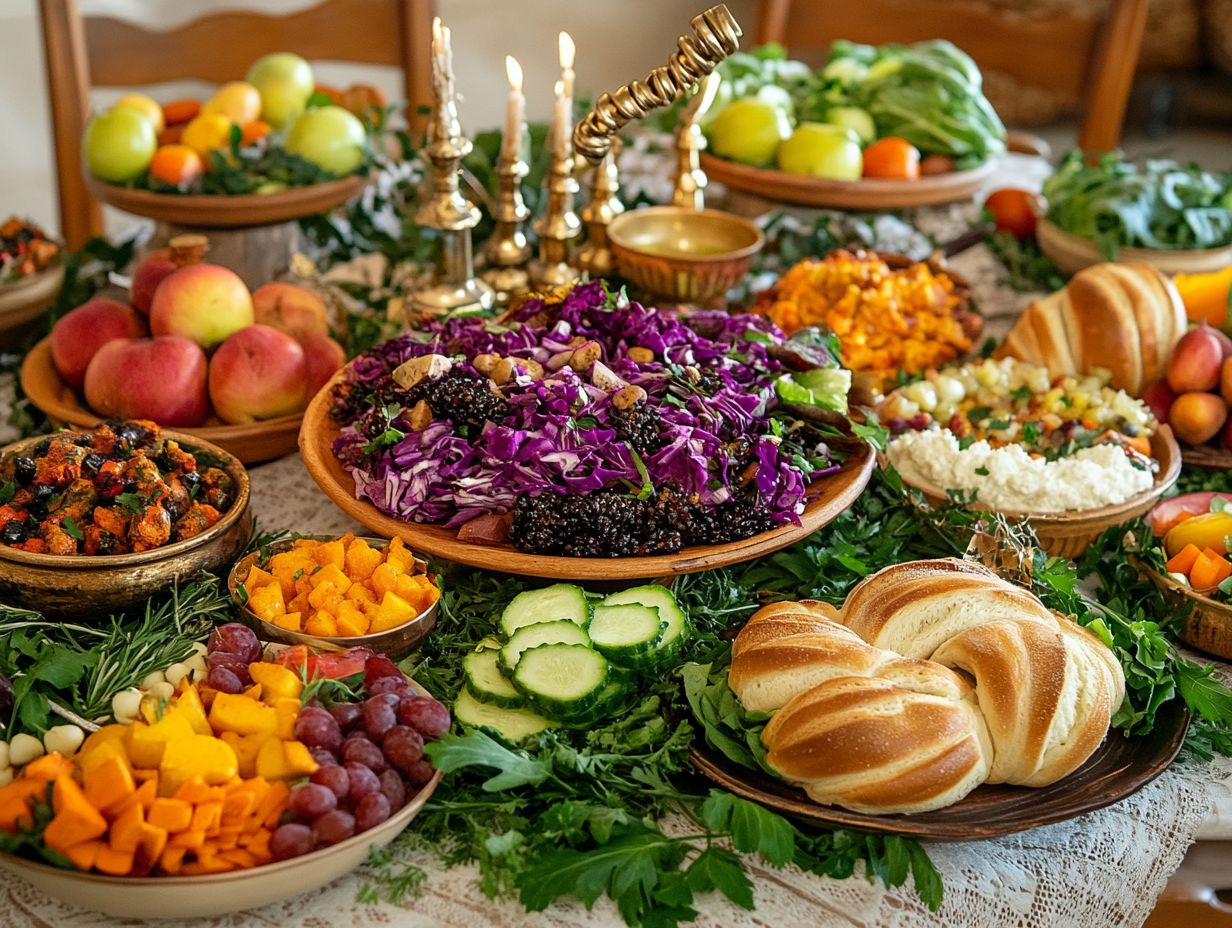
Main course vegan recipes for Rosh Hashanah enhance the holiday meal, making it heartier and more filling while providing plant-based dishes that cater to diverse tastes.
Popular choices for festive vegan meals include:
- Roasted root vegetables
- Lentil stew
- Stuffed peppers
Each dish adds vibrant flavors to the holiday table and embodies the essence of hearty foods that nourish the spirit. These flavorful, nutrient-rich meals can take center stage during family gatherings, ensuring that everyone can enjoy the holiday without compromising their dietary values.
Plant-Based Options for the Holiday Meal
You can enjoy a traditional holiday meal while incorporating plant-based options into your menu. When prepared properly, various seasonal ingredients, such as quinoa pilaf and beet salad, can harmonize a meal by offering a range of textures and flavors that are both satisfying and healthy.
These plant-based options not only emphasize the importance of wholesome and ethical eating during the holiday season but also honor ancient traditions while appealing to modern tastes. The high holidays are special occasions when people who may usually be apart come together, such as families celebrating Rosh Hashanah.
A traditional holiday meal can be simple yet festive, featuring vibrant dishes like roasted pumpkin, wild rice-stuffed peppers, and grain salads. The focus can be on the natural sweetness of root vegetables and the nutty flavor of grains, rather than elaborate preparations.
Enhancing these dishes with a tangy pomegranate dressing or fresh herbs not only elevates the flavor profiles but also adds a burst of color, making the presentation visually appealing. Sharing these plant-based recipes invites discussions about sustainable eating and health during the holidays.
Vegan Desserts for Rosh Hashanah
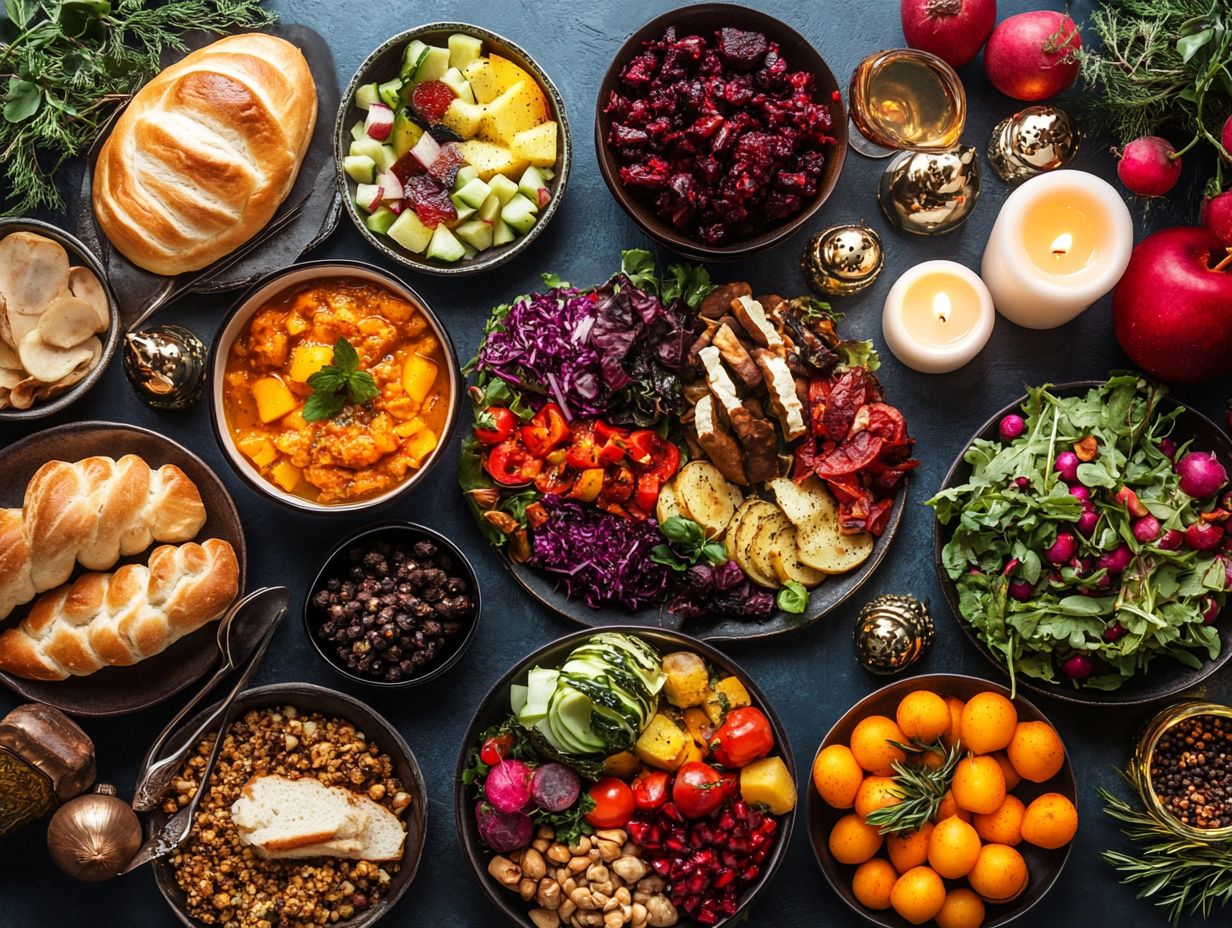
Vegan desserts for Rosh Hashanah serve as a meaningful addition to the holiday meal, offering rich and indulgent flavors that everyone can enjoy, regardless of dietary restrictions, and highlight the joy of plant-based celebrations.
From dairy-free interpretations of traditional dishes like vegan kugel and vegan honey cake to innovative desserts featuring seasonal fruits, these sweet recipes enhance the festive atmosphere and provide a satisfying conclusion to the main meal.
By incorporating honey substitutes and utilizing rich textures, these vegan desserts preserve the symbolic essence of the holiday while accommodating modern dietary preferences.
Sweet Treats to End the Meal
Sweet dishes are served at the conclusion of the Rosh Hashanah meal to symbolize the desire for a sweet new year. These comforting foods, which reflect the season, satisfy the taste buds and contribute to the holiday spirit, ensuring that no one leaves feeling hungry. This tradition emphasizes the sense of community and shared history associated with these celebrations.
The Rosh Hashanah meal typically concludes with sweet dishes made from traditional ingredients such as honey, apples, and pomegranates, which are also featured throughout the holiday. Common desserts include honey cake, apple cake, and pomegranate pastries. (For a complete list of traditional Jewish cuisine for Rosh Hashanah, see the reference.)
These traditional desserts are widely available in the Middle East and Mediterranean regions, often prepared in the homes of observant families, reflecting traditional flavors. Hirsh Goodman, a researcher and author of “Jewish Foods of the Mediterranean,” notes that many of these dishes have a rich history, having evolved over generations. For instance, the Greek dessert known as pomegranate and honey soup is believed to be a variation of a 3,000-year-old Middle Eastern dish. Alongside pomegranates, which hold significant meaning in Judaism, this dish is more likely to be enjoyed on Rosh Hashanah than in other contexts.
According to Chabad, a global Jewish educational organization, the most popular sweet foods served during the Rosh Hashanah meal today include:
- Honey cake or honey-flavored desserts (such as challah, kugel, cookies, biscuits, muffins, and pastries)
- Apple dishes (whole, chopped, or in salad form)
- Pomegranates (whole or in juice)
- Vasilopita (New Year’s bread)
- Dates and figs (fresh, dried, or in jam form)
- Sweets (candy, chocolate, and marzipan)
- An assortment of nuts and dried fruits and spices (including currants, apricots, raisins, coconut, cardamom, ginger, and cloves)
Including sweet items such as apple and honey or pomegranate in the Rosh Hashanah meal fosters gatherings of family and friends, sharing joy—an aspiration of Jewish communities worldwide during such occasions. Chabad emphasizes that even for those who are not religious, consuming these symbolic foods on Rosh Hashanah serves as a reminder to reflect on the past and contemplate hopes for the year to come. (For more on festive cuisine and traditional Rosh Hashanah foods, see the reference.)
Tips for Hosting a Vegan Rosh Hashanah with Plant-Based Dishes
Hosting a vegan Rosh Hashanah with plant-based holiday meals requires careful meal planning and consideration of guests’ dietary restrictions to create an inclusive and welcoming atmosphere.
By offering a variety of flavorful vegan dishes, such as seasonal salads and hearty main courses like lentil stew or grain salads, hosts can ensure that everyone at the table feels included in the celebration.
Open communication with guests about their preferences and providing a diverse selection of options, including vegan challah and dairy-free meals, not only enhances the festive environment but also embodies the essence of community and shared culinary experiences.
How to Accommodate Dietary Restrictions with Festive Vegan Cuisine
Accommodating dietary restrictions with festive cuisine during Rosh Hashanah ensures that all guests can enjoy the celebration without worrying about their unique needs.
By offering a variety of vegan options, gluten-free recipes, and nut-free dishes, along with sweet and savory selections like vegetable kugel or tzimmis, hosts create a more inclusive dining experience that respects individual dietary preferences while sharing delicious flavors.
Thoughtful meal planning can include vegan side dishes, a mix of savory pies, fresh salads, and hearty entrees that cater to various restrictions while maintaining the festive spirit of the holiday. This approach not only fosters a sense of belonging but also showcases the culinary diversity that can be achieved within dietary limitations.
For instance, a vibrant quinoa salad packed with vegetables and drizzled with tahini dressing can serve as a nutrient-dense side dish rich in healthy fats. Additionally, a vegan apple pie with an almond flour crust can provide a sweet, comforting dessert that everyone can enjoy. Complementing these, nut cake or fruit salads enhance the holiday table with their vibrant flavors.
By incorporating such dishes into the menu, hosts can ensure that all attendees feel appreciated while also highlighting the rich culinary traditions and festive gatherings associated with the holiday.

